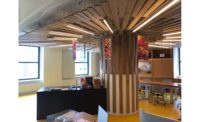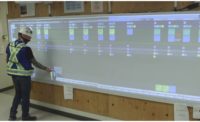A U.S.-Norwegian company, Kolos, has chosen a tiny, remote coastal town in northern Norway to build what it says will be the world's largest data center. The site was selected for its ability to provide clean power and low-cost cooling needed by the growing data storage demands of mega-customers such as Facebook and Google.
The 6.4-million-sq-ft, 1-GW (1,000 MW) Kolos Data Center in Ballangen will be powered entirely by renewable hydroelectric power provided by Norway’s state-run utility, Statkraft.
The center will take advantage of the average 35-deg F year-round air temperature, supplemented by cold fresh water from the spillway of the nearest hydroelectric dam if air outside gets too warm, says Kevin LeMans, a principal in Dallas-based HDR, which is is designing the facility that is expected to start construction by the end of 2018 with a 10-year construction period due to its size. Kolos says the project's total cost will likely be around $15 billion.
LeMans says the key to keeping energy consumption low and the carbon footprint light is in using the outdoor environment to cool the servers, rather than energy-intensive chilled water systems. “We will have air handling units with heat exchangers that leverage cold outside air to cool the data center," he says. "Outside air, warmed via the heat exchanger, will be exhausted through the roof.”
Scandinavia has been a favored site for data centers. Facebook has its own facility in Sweden less than 240 miles away, and Microsoft has a fjord-cooled data center also in Norway.
The country is a technological pioneer in hydropower generation, although its long-distance energy transmission capabilities are constrained. The electrical grid is not able to transport Statkraft’s hydropower generated near Ballangen very far without transmission loss, and under Norway’s regulations, Statkraft can be penalized for creating a surplus of power without an ability to use it.
However, companies that come in and consume the current local power imbalance can get a bonus for correcting it.
Havard Lillebo, co-CEO of Kolos, says the main idea for dealing with the power imbalance problem, dating back to the 1950s, is "to bring energy-intensive industries close to where the power is produced to eliminate transmission losses.” He says the energy-generating potential in the area is even larger than the needs of the planned facility, but it is designed to scale up to a possible 2 GW of consumption in the future.
"An official at Statkraft says he is more than willing to sell his entire production to us and that could lead to expansion of power production in the area,” Lillibo says.
The form of the design is one continuous spine connecting many data center buildings to mimic a glacier moving over the mountainous terrain. The spine follows the abandoned copper mine and many of the buildings will be situated in old mining recesses. Copper was specified for the roofs of all the buildings to recognize Ballangen’s heritage as a former copper and zinc mining town.
“There are three primary reasons for the design,” says Mark Robinson, Kolos’ other CEO. “There are data center modules underneath many of the buildings. The form we used optimized layout of those modules. It’s also dead-center in the middle of the town, which rises around it. We wanted it to be architecturally sensitive to the community. Finally, the conical shape we used focuses the sound downward and not into the air. It’s a good sound barrier and would block the noise the data center creates from the residents’ homes.”
When it opens in 2028, the data center will directly create 2,000 to 3,000 jobs and support 10,000 to 15,000 others in the area, says Robinson.





Post a comment to this article
Report Abusive Comment